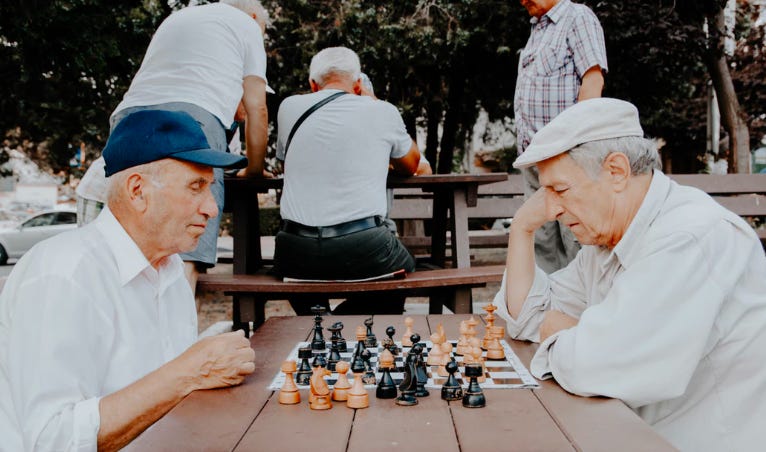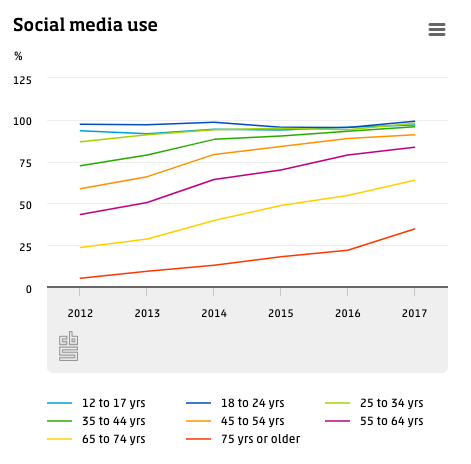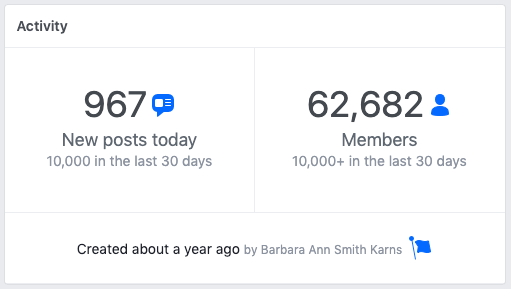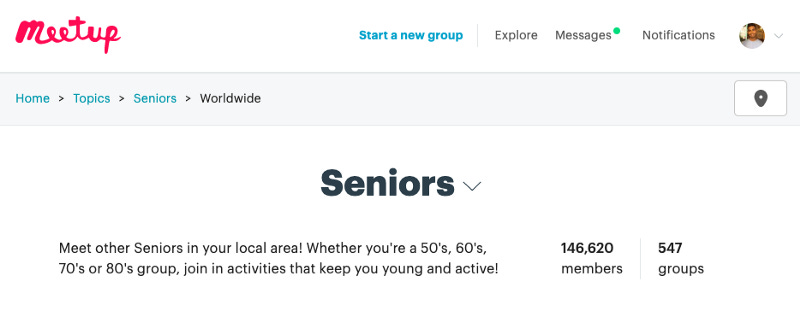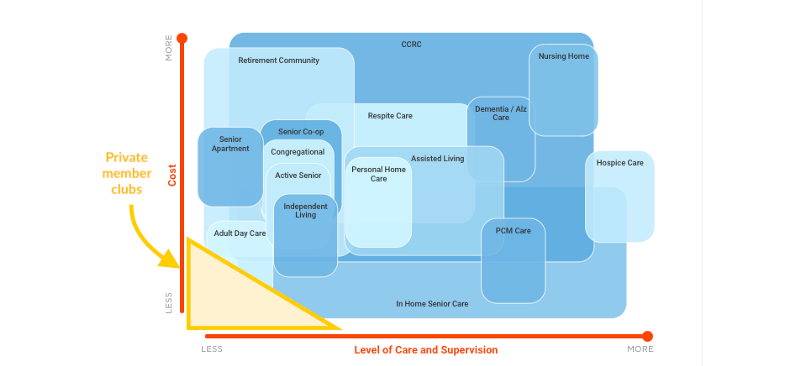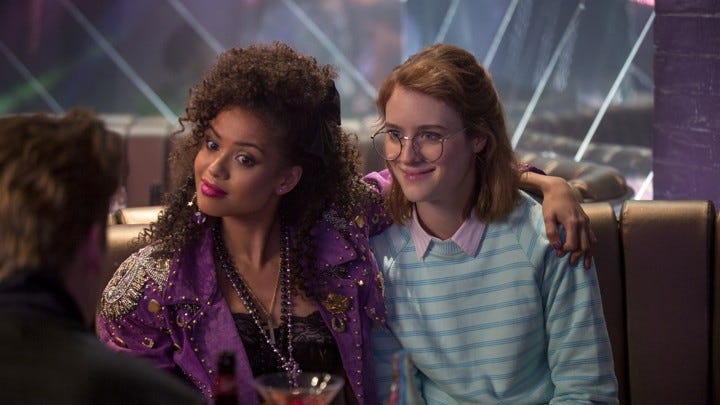Venture Opportunities — Senior Social
An abundance of opportunity
An abundance of opportunity
Large market, 40m people are aged 60+ in the United States
Known problems — geriatric depression, isolation, loneliness, lack of fulfillment, chronic illness, cognitive decline
Increasing online presence, 35%+ of 65-year-olds on social platforms
Social, context
Older adults represent the fastest-growing group of the world’s population as lifespans extend. As people age, their physical capacities begin to degenerate, leading to limited mobility. Such a limitation often manifests in less participation in social activities, which has been shown to increase feelings of loneliness and decrease morale and satisfaction with life.
It is also well known that for the elderly, health and well-being primarily depends on the emotional and social relationships they have with their family members and friends. Resultantly, finding ways to support older people in establishing and maintaining social networks should be a priority for public health.
Social platforms have become a part of everyday life for many older people. From 2000 to 2009, there was a 70% increase in Internet use by people aged 50–64 years. As of 2017, 34% of 65 to 74-year-olds use social networks, such as Facebook, as against 12% five years prior. In the oldest age group (75 years and over), the share of active social network users went up from 2% in 2012 to 17.3% in 2017.
Technology will play an important role in helping the elderly maintain social connections. It can improve their quality of life by reducing their sense of isolation, contributing to their psychological well-being and sense of empowerment, and supporting their relationships regardless of time and location.
Engagement on Facebook
In the U.S., older Americans are the fastest-growing group on Facebook. While the primary use is to better connect with friends and family, seniors also are actively engaged in interest-focused groups such as Senior Planet (16k members), Senior Moment (1k), and others. More specific groups include Activities for Seniors (7k), Sassy Seniors Club (17k), etc.
Notably, a comedy-focused group called “Surviving Silly Sassy Seniors” is just one year old and sees really high engagement.
It’s unclear if Facebook has built the best communication tools for these interest-specific groups, or if they simply benefit from the obvious network effect. If the latter is true, then perhaps this means there’s an opportunity to unbundle. Nextdoor has done this successfully, drawing a large audience of seniors, oriented around the shared interest of their neighborhood community.
Other convenings
Meetup has been an interesting gathering point for seniors as well
Chicago-based Brio is creating a marketplace of senior-friendly experiences.
Brio Experiences
Brio connects senior adults to meaningful experiences in their neighborhoods.www.brioexperiences.com
Companionship models are also emerging. Companies like Papa connect college-age individuals to older adults who can benefit from daily assistance and companionship.
Papa - Grandkids On-Demand - Assistance and Socialization for Seniors
Papa offers the following senior services for people still living at home or at independent living facilities…www.joinpapa.com
A novel way to attack elder loneliness and isolation is by engaging seniors as a workforce in childcare. As an example, Singaporean companies have actively co-located care centers for the elderly and children.
'It's like I'm part of life again': The magic when seniors and kids do daycare together
As Singapore starts to co-locate care centres for the elderly and children, CNA Insider visits a groundbreaking project…www.channelnewsasia.com
In the U.S., companies like Poppy were built on a similar thesis. Though Poppy is no longer an active company, there’s an opportunity to tap into the available elder population to add value in childcare, while simultaneously solving for isolation.
New opportunities (RFS)
What does social + fitness look like?
For elders, the thought of mixing with the Barry’s crowd or cycling to heavy metal isn’t all that appealing.
A couple of ideas —
Perhaps there’s an opportunity to create a chain of senior-only fitness centers with age-safe classes, optimized for mobility concerns and disability access.
Alternatively, could a ClassPass style intermediary aggregate a number of age-friendly courses across gyms complemented by a mobility solution? (Lyft integration for rides to/ from the gym, all covered under membership fee) I’d be interested to know how many seniors would meaningfully engage in fitness if concerns around age-friendly courses and mobility were eliminated.
Soho House for seniors
This concept was brought up a while ago on Erik Torenberg’s Venture Stories podcast. See here for “Opportunities in Eldercare and Aging with Natalie Dillon, Lisa Marrone, and Shawn Xu”.
Soho House, originally a club in London’s West End has ambitiously grown since its inception, though there are few spaces like this for seniors. Private member clubs for seniors would require a different set of design criteria, with special consideration to transportation, accessibility, and meal options.
Where social meets health 🏥
For most seniors, managing the health concerns that accompany aging are a part of daily life. Simultaneously — and with increasing efficacy — social is proving to be a powerful tool in behavioral health management. Online group therapy models have proven useful for new, digital therapeutics. Omada is a great example — using digital social to stimulate competition within a cohort of similar pre-diabetics. Could the same be applied to other forms of chronic illness management common to elders? — in collaborative ways instead of competitive?
Side Note: Over the last few months, I’ve been working with a team to incubate June Care, focused on creating digital communities for families supporting Alzheimer’s and dementia patients. If you’re interested in this, or adjacent spaces, please reach out!
Virtual youth?
A few interesting ventures are already pioneering models in this space. The leading assumption is that if VR adoption in younger generations has been lacking, it could be a long time before these platforms see the adoption of senior populations. However, the ‘San Junipero’ concept is an exciting one because VR offers access to a world where mobility and accessibility aren’t a concern. Perhaps, seniors are the group that benefits most from the experience for this reason — that is to say, they have the biggest pain point. There are a few companies already exploring the space, notably Mynd and Rendever.
Mynd Virtual Reality | Virtual Reality for Seniors
MyndVR is creating a new genre of entertaining and therapeutic experiences in Virtual Reality specifically designed for…www.myndvr.com
Virtual Reality for Seniors | Welcome to Rendever
Rendever's virtual reality platform gives residents of the best assisted living and senior care communities the ability…rendever.com
Conclusion —
An abundance of opportunities exists in senior-social. Long overlooked, seniors are now increasingly comfortable using the web and deeply engaged on social platforms. Coupled with real problems (isolation, loneliness) and high consumer spending potential, I’m excited for what the next decade of elder tech holds.
As always, the thoughts above are an eternal draft, which I plan to update as I learn more.
Thanks for reading!
I’m always open to learn and collaborate. Feel free to reach me — 2amritsingh2@gmail.com

